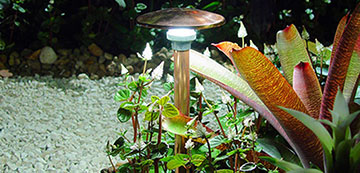Within the serene field of garden design, lighting is essential for setting the mood, guaranteeing security, and bringing out the best features of your outdoor area. Traditionally, halogen or incandescent light bulbs have been used to illuminate gardens. But in the realm of outdoor lighting, Light-Emitting Diode (LED) technology has been a game-changer in recent years. The advantages of LED lighting for gardens are discussed in this article, including its eco-friendliness, longevity, and energy efficiency. In order to assist you in selecting the ideal lighting solution for your garden, we will also provide a comparison between LED and conventional lighting.
The Revolution of LEDs
In the lighting sector, LEDs have completely changed things, and for good cause. There are many benefits to using these compact, energy-saving light bulbs for outdoor lighting. Now let’s examine the main advantages that set LEDs apart from conventional lighting sources:
- Effectiveness of Energy
- The exceptional energy economy of LED landscape lighting is one of its biggest benefits. Compared to incandescent or halogen lights, LEDs use a lot less energy to produce the same quantity of light. In the end, this results in significant energy savings and cheaper electricity costs, benefiting both your garden and your wallet.
- Lifespan
- When compared to conventional bulbs, the lifespan of LEDs is remarkably extended. For example, an LED bulb can last up to 25,000 hours or longer, whereas a regular bulb may need to be changed out after much less time. This translates to less maintenance and repairs, which is especially helpful for outdoor lighting fixtures that can be difficult to reach.
- Sustainable
- LEDs don’t harm the environment. They are entirely recyclable and free of dangerous substances like mercury, which is present in fluorescent lights. LEDs are a greener option for your landscape since they require less energy and produce fewer greenhouse gas emissions.
- Sturdiness
- LEDs have an extremely high level of durability and are immune to vibration, shock, and drastic temperature changes. Due to their resilience to weather, they are ideal for outdoor applications, where they can endure rough handling and changes in temperature without sacrificing functionality.
- Design Flexibility
- Due to their versatility in size and style, LEDs provide endless design options for outdoor lighting. To fit the design of your garden, a variety of fixtures are available, such as pathway lights, spotlights, and string lights.
LED vs. Conventional: A Comparative Study
After discussing the advantages of LED lighting, let’s see how they stack up against more conventional choices like halogen and incandescent bulbs:
- Energy Use: LED lights use up to 90% less energy than conventional bulbs, which will drastically lower your utility costs.
- Duration: The average lifespan of LED bulbs can be up to 25 times greater than that of incandescent bulbs and 10 times longer than that of halogen lamps.
- Heat Emission: Compared to incandescent bulbs, which have the potential to burn extremely hot, LEDs release remarkably little heat. In particular, this makes LEDs safer when used near plants.
- Colour Range: The large colour range that LEDs provide makes it simpler to achieve a variety of moods and effects in your landscape. Conventional bulbs frequently emit a narrow spectrum of colours.
- Initial Cost: Although LED bulbs often cost more upfront, over time, they save a lot of money thanks to their extended lifespan and energy efficiency.
Selecting Your Outdoor Lighting Option
The decision between LED and conventional garden lighting ultimately comes down to your own requirements and tastes. LED lighting has many advantages, including lifespan, energy economy, and environmental friendliness. However, switching to LEDs may require some upfront costs if your current yard lighting system uses conventional bulbs. Even so, the long-term benefits frequently offset the upfront expenses.
In conclusion, LED technology is a shining example of effectiveness, sustainability, and adaptability when it comes to landscape lighting. By switching to LED garden lights, or often existing fittings can be converted to LED, you’re improving your outdoor area’s aesthetics and safety while also helping to ensure a more sustainable future. It’s a wise decision that clears the air in both your garden and your conscience.
Are LEDs a good fit for your landscape, then? The answer is unquestionably “yes,” as long as you take into account your unique lighting needs and seek out the many advantages they give. Both the environment and your garden will appreciate the change.

